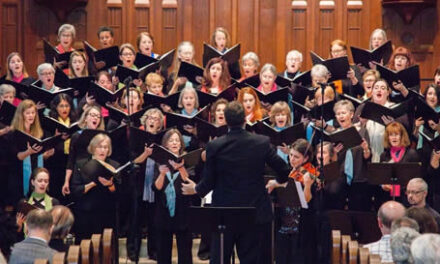 The NC Symphony‘s latest performance was all about the strings – with guest conductor Andrew Grams, the orchestra’s entire string section performed two contrasting works by Jessie Montgomery and Peter Illyich Tchaikovsky. The NCS seems to be expanding the number of performers onstage, still with masks and distance employed. Grams, in his pre-concert interview with host Joseph Peters, expressed his gratefulness for sharing the orchestra’s stage and seeing friends and colleagues for the first time in a while.
The NC Symphony‘s latest performance was all about the strings – with guest conductor Andrew Grams, the orchestra’s entire string section performed two contrasting works by Jessie Montgomery and Peter Illyich Tchaikovsky. The NCS seems to be expanding the number of performers onstage, still with masks and distance employed. Grams, in his pre-concert interview with host Joseph Peters, expressed his gratefulness for sharing the orchestra’s stage and seeing friends and colleagues for the first time in a while.
Grams, a friend of composer and violinist Montgomery, was conducting her work for the first time on this program. Montgomery’s piece Banner, its title a nod to its original inspiration, the 200th anniversary of “The Star-Spangled Banner.” Montgomery thrillingly tests the boundaries of string playing techniques, as only a violinist can. Given this work’s origins, a phrase that comes to mind would be “melting pot” – a somewhat-controlled cacophony, full of bravado. Unusual textures abound, especially in the third section, which is nicknamed “drumline” for its percussive emulation. The double bass players hit the wood of their instrument like a bass drum, while the other strings played rapid scratches or used their bow to hit the strings. Then, melodies begin to burst through, and the cellos and basses flow underneath, resulting in a heart-pounding, exciting texture. Through it all, Grams confidently led the way through the complex rhythm overlapping.
Tchaikovsky’s beloved Serenade for Strings in C contains several examples of what the concert’s host Peters dubbed an “earworm” – a memorable, repeated melody that is both comforting and delightful to hear time and time again. The music of Tchaikovsky is full of these earworms, and in this Serenade, they are as simple as ever: more or less based on the upward and downward direction of the scale. That is not to say that these melodies are played simply – in fact, the NC Symphony’s strings employed such a high level of solo expression, the straightforward, familiar melodies were made new again. The first movement, a sonatina, featured beautiful chordal harmonies as well as canon-style repetition among string sections. With the latter texture, the musicians persuasively mirrored their articulation for each phrase. This was also true in the Serenade’s third movement, a larghetto Elégie that Peters described as the “emotional heart” of the work. The movement’s tender melodies were traded evenly between high and low strings, who together built tension that did not subside until the final pianissimo cadence.
For his part, conductor Grams was equally expressive, especially at pauses and cadences. Throughout all four movements, Grams’ sense of rubato was just right, especially at the softer cadences, and made for several special moments. It was obvious that Grams had made communication an extremely high priority for this performance. After Tchaikovsky’s triumphant Finale, the NCS strings went ahead and added an encore (a rarity these days, it seems) of “Pizzicato Polka” by Johann Strauss Jr. and Josef Strauss. It was joyfully and dynamically sculpted, and a lovely exclamation point on the program after the Serenade.












